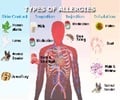- Know More About Anaphylaxis - (http://www.mayoclinic.org/diseases-conditions/anaphylaxis/basics/definition/con-20014324)
- About Anaphylaxis - (http://acaai.org/allergies/anaphylaxis)
- ANAPHYLAXIS OVERVIEW - (https://www.aaaai.org/conditions-and-treatments/allergies/anaphylaxis.aspx)
- More on ANAPHYLAXIS - (https://www.foodallergy.org/anaphylaxis)
- Anaphylaxis - (https://en.wikipedia.org/wiki/anaphylaxis)
What is Anaphylaxis?
Anaphylaxis is a sudden, severe and life-threatening manifestation of an allergic reaction. Commonly caused by insect bites or stings, medications and food such as peanuts, anaphylaxis shows up with symptoms like tongue swelling, itchy rash, vomiting, shortness of breath, lightheadedness or low blood pressure.

What are the Causes of Anaphylaxis?
Anaphylaxis is caused by a substance that the body recognizes as a potential danger and over-reacts to respond to it. People who have existing conditions like asthma, allergic rhinitis, etc. may be prone to anaphylaxis from food items.
Causes of anaphylaxis can be categorized as follows:
Food: Certain foods cause a disturbance in the immune system, most often the first time after ingestion. Common foods that are known to trigger anaphylaxis vary across the geographic areas of the world.
- People in Western countries are known to be allergic to foods like peanuts, wheat (for its gluten content), nuts, seafood like shellfish, milk, and eggs.
- In the Middle East, sesame is the most commonly known trigger.
- Asians are found to have such reactions to milk, rice and chickpeas.
Foods such as meat (beef, chicken, mutton or pork), corn, fruits (apple, peach), vegetables (carrot, tomato, yam) are also known to cause anaphylaxis in a few persons.

Medication: Most commonly known medicines that may cause anaphylaxis are penicillin, aspirin and NSAIDs. Some children may be affected by vaccines. Vancomycin, morphine and chemotherapy have also been reported as potential triggers of anaphylaxis.
Insect stings: Stings from insects like wasps, bees, fire ants, and kissing bugs may cause anaphylaxis in people who are vulnerable.
Latex (the liquid that oozes out of plants) from a few plants and is used to manufacture items like hand gloves can trigger anaphylaxis. People suffering from asthma and other atopic diseases are more susceptible to anaphylaxis. Exercise is also known to trigger anaphylaxis in the vulnerable group.
Catamenial anaphylaxis: Hypersensitivity that is caused by secretion of a hormone called progesterone by the body is called catamenial anaphylaxis. This anaphylaxis typically occurs before the onset of the bleeding during a menstrual cycle in women.
What are the Symptoms of Anaphylaxis?
Symptoms of anaphylaxis can manifest within a few minutes or may sometimes take a few hours. In the case of food, the onset of symptoms may occur after about 2 hours of eating. The symptoms occur mostly in the respiratory tract, skin, heart and blood vessels, digestive system and the nervous system.
Respiratory tract symptoms:
- Shortness of breath
- Wheezing
- High-pitched breathing sound (stridor)
- Hoarseness of voice, pain while swallowing

Symptoms of the skin:
- Itching and rashes
- Swelling of the affected areas
- Hives – A type of skin rash that is pale red, raised and bumpy and very itchy
- Rarely, skin may turn bluish due to lack of oxygen
Symptoms related to heart and blood vessels:
- Spasm of the coronary artery (the artery that supplies oxygen-rich blood to the heart muscles)
- Cardiac arrest or heart attack
- Irregular heartbeat
- A sudden drop in blood pressure or shock
Symptoms of the digestive system:
- Nausea and vomiting
- Abdominal pain or cramps
- Diarrhea
Central nervous system symptoms:
- Loss of consciousness or light-headedness
- Headache due to dilation of blood vessels in the brain
- Anxiety and a feeling of doom
- Confusion
Other symptoms include:
- Swelling of the conjunctiva, the lining of the eye
- Loss of bladder control
- Pelvic pain

The above-mentioned symptoms may present in combination. Sometimes, the first reaction may occur moderately and subside, only to flare up as a secondary anaphylactic reaction, known as biphasic reaction, within the next 12 hours.
There are also reports of a person going to shock or death without the manifestation of any milder symptom at all.
Diagnosis of Anaphylaxis
Anaphylaxis is diagnosed on the basis of the development of life-threatening symptoms, after a possible contact with a substance that is likely to trigger an allergy.
Once the condition is under control, the doctor will enquire about any previous episodes of allergy. The queries may be based on:
- Reactions to particular food
- Reactions to any medicine
- Rashes or redness of skin on exposure to latex or other substances
- Reactions to sting of any insect
Diagnostic tests: Since anaphylaxis is a life-threatening situation, there is no time to carry out diagnostic tests. Tests that may be conducted at a later date include the following:
- Allergy testing: Skin allergy testing or patch testing can be done for certain food items and penicillin.
- Blood test of immunoglobin E (a type of antibody) can be used to confirm allergic reaction to foods such as milk, egg and peanut.

How Do You treat Anaphylaxis?
Anaphylaxis calls for an emergency intervention.
An immediate intramuscular injection of epinephrine (adrenaline) is the first treatment given for anaphylaxis. If the response to the treatment is not as expected, the epinephrine must be given every 5 to 15 minutes. Epinephrine has to be injected in dilute form if it is to be given intravenously.
Antihistamines may be effective in treating mild allergic reactions, but have not shown to be effective for anaphylaxis. Nebulized salbutamol has been used to relieve respiratory symptoms when epinephrine has not worked.
Supportive treatment like supplemental oxygen, improving breathing by inserting a tube into the windpipe, cardiopulmonary resuscitation and administering intravenous fluids have to be given.
Allergen Immunotherapy: Anaphylaxis caused by natural allergens like insect bites can benefit from allergen immunotherapy. The procedure is also known as desensitization or hyposensitization. The procedure involves exposing the patient to increasingly larger doses of the specific allergen. This is done to change the immune system’s response.
The allergen is injected subcutaneously or given sublingually (under the tongue) or orally. The dosages are commonly called allergy shots. This treatment is done after the patient has recovered from the anaphylactic attack.

Coping with Anaphylaxis
People who have had an anaphylactic attack in the past have to be cautious about their intake and exposure to other possible allergens also. It is essential for people who are vulnerable to anaphylactic attacks to take measure to prevent exposure to known and possible allergens.
- Seek professional help. Be ready and prepared for an anaphylactic attack (that may or may not occur) immediately after the first anaphylactic reaction. Seek a physician or an allergist who can help in the further management of the problem.
- An auto-injector epinephrine kit, prescribed by your physician, can be kept handy all the time. Single doses of epinephrine are available in various concentration and your allergist can prescribe the most suitable one.
- Know your allergen. Each person will be allergic to different substances. Understand and know what has caused an anaphylactic attack in the past and what can possibly cause another one. A list of stimulants of allergy can be identified and listed down with the help of your physician or an allergist.
- Avoid your allergen. Once the list of known and possible triggers are identified, these things can be avoided. There may be a need to make changes in eating habits, working conditions or lifestyle.
- Keep away from insects and places where insects may be present. Avoid wearing bright flowery dresses and sweet smelling perfumes, lotions or hairsprays.
- Check food labels for the ingredients before buying them. While eating out, ask at the restaurant about the ingredients used and how the food is prepared.

- Be prepared to react effectively to a possible anaphylactic attack that comes unexpectedly. Family, friends, co-workers, teachers and other significant people must be made aware of the condition and know to recognize the symptoms of an anaphylactic reaction.
- Even after first aid for an anaphylactic attack, seek further treatment for the same. There are chances of a biphasic attack (secondary attack) flaring up within next 2 to 24 hours.
- Wearing an identification that mentions the vulnerability to substances and how to handle an emergency can help if the person is always on the move.
- For a child with a history of anaphylactic attack, inform the school teacher about the possible triggers and how to handle an attack. If required, an epinephrine kit can be kept handy at school.
Health Tips
- Keep your home and the workplace free from dust.
- If you are allergic to latex, avoid growing flowering plants at home. This will also prevent insects entering the house.
- Wear protective shoes while walking in grass or fields.
- Check labels of foods you buy for any ingredient that you may be allergic.
- Avoid ready-to-eat foods and fast foods. If necessary, avoid eating out.










